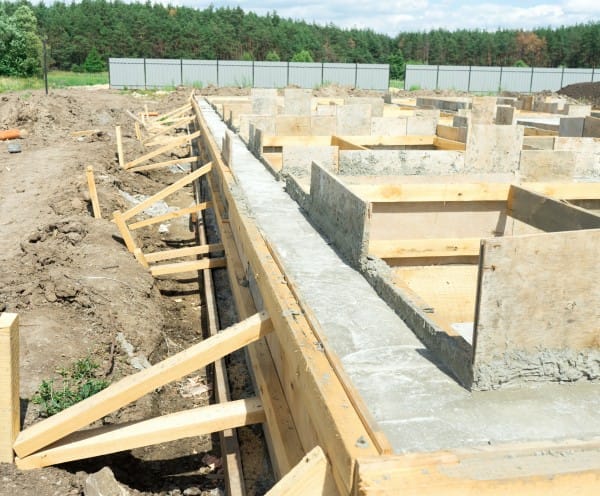Solid Foundations Require Care Taken at Every Stage
More than merely functioning to hold the house above ground, a well-built foundation keeps out moisture, insulates, and resists movement of the earth around it. Exercising care at every stage of the process — design, preparing the subgrade, placing, finishing, and curing— can help prevent failures or costly repairs down the road.
The first step in designing the foundation is to get a geotechnical investigations and report completed by a geotechnical engineer to analyze the composition of the soil. Both lab tests and field testing are necessary to ensure that everything within your ground is going to provide a solid foundation.
Strong soil does not expand or contract excessively when exposed to moisture, and it has a good density, which means it won’t greatly compact or settle after construction is complete.
Weak soil may expand or contract 10 percent or more due to the moisture content. It may also be loose and prone to erosion, or it may show a tendency to significantly compress when put under pressure. Soils loaded with clay or organic matter hold water like a sponge, increasing the risk of foundation cracks when the soil freezes and expands. Dry soil caused by drought conditions is an enemy, too.


The slab foundations most commonly used in Texas are comprised of a sturdy footing and a vapor-proofed reinforced concrete pad that sits on a bed of compacted crushed stone. Chemical or water injections as well as moisture conditioning testing and inspection may be recommended to reduce or eliminate the ability of the soil beneath the foundation to shrink or swell as the water content changes. Alternatively, the geotechnical engineer may specify foundation piers to get to the bedrock or stiffer more solid soil below.
Soils with different bearing capacity across the area of the slab and improper compaction of the subgrade are the most common causes of subgrade settlement. Prepping the site with proper grading to prevent erosion and address drainage is another vital step. Experts recommend that ideally the ground should drop one inch for every one foot that you move away from the house for the first 5-to-10 feet around your house. The site should also be checked for uniform bearing capacity of the subgrade.
Most homesites will require some degree of fill dirt. For the backfill, it is vital to use nonporous soils. But even the best of fill dirt is not typically compacted as well as Mother Nature does it. Un-compacted fill dirt can compress over time leading to settlement. Soil should be compacted in lifts, ideally about six inches at a time. A compaction test will be expressed as a percentage at optimal moisture content. 95% compaction means that the soil on the construction site has been compacted to 95% of the maximum density achieved in the lab. Retaining walls may also be required to hold the fill dirt.

Texas ProChemical’s tractors utilize high pressure pumps and injection masts capable of injecting highly active clays to a maximum depth of 15 feet. Soil injections change the electrochemical nature of soil to inhibit its ability to associate with water, thereby minimizing the soils’ basic swell/shrink characteristics and increasing its compressive strength and support value.
READ OUR SAVVY SPECIAL REPORT ON TEXAS PROCHEMICAL’S SOIL INJECTION SERVICE

Timing of the pour is everything. Sometimes, weather conditions can cause difficulties with grading and drainage causing the site to get too wet before compaction can take place. What constitutes too wet will vary with soil types, but it doesn’t have to look muddy to be too wet. The concrete form should be filled in one go to avoid a “cold joint” between different layers of concrete.
Concrete must cure slowly to reach its proper strength and that means keeping it damp for at least three days which may involve wrapping it in plastic, misting it with water and other techniques. Rushing the cure can also lead to a foundation failure.
New technologies include “super plasticizers,” a chemical that makes it possible to pour a mix that flows almost like water while retaining structural integrity; like water on a lake, the liquidity of the super plasticized concrete helps it automatically set level. Lightweight foundation forms made of high-density polyethylene fabric flex to conform easily to sloping and uneven sites, which simplifies excavation. The fabric stays in place as a built-in, damp-proofing membrane and the bulging sides of the finished footings help divert water away from the foundation.
Your engineer of record will specify the ideal foundation design and construction phase observations to be incorporated into the foundation construction but assuring the long-term performance of the foundation structure doesn’t stop after the foundation is poured. Educate your homebuyers about landscaping best practices. Provide guidelines or even follow up with an email or text during extreme weather events. A reminder to keep the ground moist during times of drought, or to monitor and manage drainage during the rainy season, shows that you care.
THE BOTTOM LINE:
Remember that many Texas homebuyers are newcomers to our state. Helping them understand your preventative processes and procedures for building foundations can ease their fears and concerns.
It’s also important to set their expectations with regard to a normal amount of settling after move-in and their responsibilities in maintaining their home’s structural integrity. Communication is the key!
DOWNLOAD THIS ARTICLE AS APPEARED IN BUILDING SAVVY MAGAZINE
THANK YOU TO MLAW ENGINEERS/MLA GEOTECHNICAL FOR SPONSORING THIS FEATURE ARTICLE.

